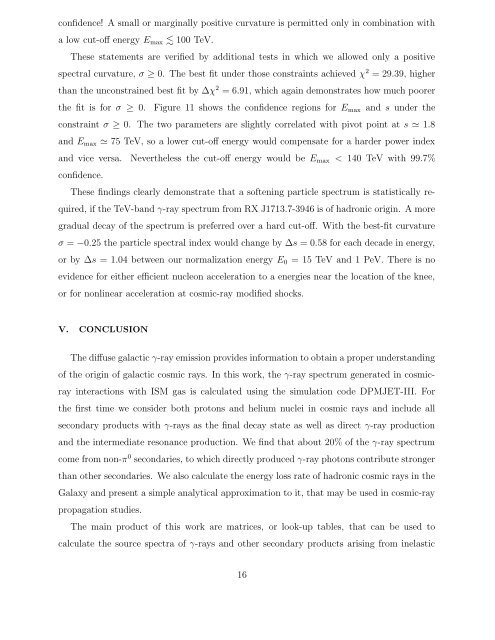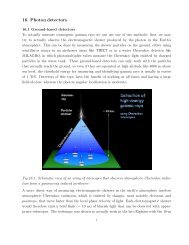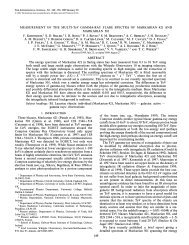Gamma-Rays Produced in Cosmic-Ray Interactions and TeV-band ...
Gamma-Rays Produced in Cosmic-Ray Interactions and TeV-band ...
Gamma-Rays Produced in Cosmic-Ray Interactions and TeV-band ...
Create successful ePaper yourself
Turn your PDF publications into a flip-book with our unique Google optimized e-Paper software.
confidence! A small or marg<strong>in</strong>ally positive curvature is permitted only <strong>in</strong> comb<strong>in</strong>ation with<br />
a low cut-off energy E max 100 <strong>TeV</strong>.<br />
These statements are verified by additional tests <strong>in</strong> which we allowed only a positive<br />
spectral curvature, σ ≥ 0. The best fit under those constra<strong>in</strong>ts achieved χ 2 = 29.39, higher<br />
than the unconstra<strong>in</strong>ed best fit by ∆χ 2 = 6.91, which aga<strong>in</strong> demonstrates how much poorer<br />
the fit is for σ ≥ 0. Figure 11 shows the confidence regions for E max <strong>and</strong> s under the<br />
constra<strong>in</strong>t σ ≥ 0. The two parameters are slightly correlated with pivot po<strong>in</strong>t at s ≃ 1.8<br />
<strong>and</strong> E max ≃ 75 <strong>TeV</strong>, so a lower cut-off energy would compensate for a harder power <strong>in</strong>dex<br />
<strong>and</strong> vice versa. Nevertheless the cut-off energy would be E max < 140 <strong>TeV</strong> with 99.7%<br />
confidence.<br />
These f<strong>in</strong>d<strong>in</strong>gs clearly demonstrate that a soften<strong>in</strong>g particle spectrum is statistically required,<br />
if the <strong>TeV</strong>-b<strong>and</strong> γ-ray spectrum from RX J1713.7-3946 is of hadronic orig<strong>in</strong>. A more<br />
gradual decay of the spectrum is preferred over a hard cut-off. With the best-fit curvature<br />
σ = −0.25 the particle spectral <strong>in</strong>dex would change by ∆s = 0.58 for each decade <strong>in</strong> energy,<br />
or by ∆s = 1.04 between our normalization energy E 0 = 15 <strong>TeV</strong> <strong>and</strong> 1 PeV. There is no<br />
evidence for either efficient nucleon acceleration to a energies near the location of the knee,<br />
or for nonl<strong>in</strong>ear acceleration at cosmic-ray modified shocks.<br />
V. CONCLUSION<br />
The diffuse galactic γ-ray emission provides <strong>in</strong>formation to obta<strong>in</strong> a proper underst<strong>and</strong><strong>in</strong>g<br />
of the orig<strong>in</strong> of galactic cosmic rays. In this work, the γ-ray spectrum generated <strong>in</strong> cosmicray<br />
<strong>in</strong>teractions with ISM gas is calculated us<strong>in</strong>g the simulation code DPMJET-III. For<br />
the first time we consider both protons <strong>and</strong> helium nuclei <strong>in</strong> cosmic rays <strong>and</strong> <strong>in</strong>clude all<br />
secondary products with γ-rays as the f<strong>in</strong>al decay state as well as direct γ-ray production<br />
<strong>and</strong> the <strong>in</strong>termediate resonance production. We f<strong>in</strong>d that about 20% of the γ-ray spectrum<br />
come from non-π 0 secondaries, to which directly produced γ-ray photons contribute stronger<br />
than other secondaries. We also calculate the energy loss rate of hadronic cosmic rays <strong>in</strong> the<br />
Galaxy <strong>and</strong> present a simple analytical approximation to it, that may be used <strong>in</strong> cosmic-ray<br />
propagation studies.<br />
The ma<strong>in</strong> product of this work are matrices, or look-up tables, that can be used to<br />
calculate the source spectra of γ-rays <strong>and</strong> other secondary products aris<strong>in</strong>g from <strong>in</strong>elastic<br />
16







